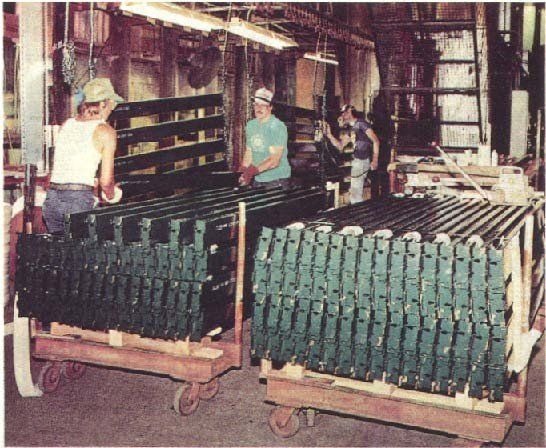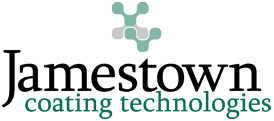Testimonials
PF Online - Borroughs Corp.

Waterborne Dip Coating
Borroughs switched to a waterborne dip coating because it provided a thicker coating at a lower cost. But, it was the service from it's paint supplier that has really made the difference... ~Steven R. Kline, Jr.
When you think of dipping parts into a tank to coat them, some of the first words that probably come to mind are electrocoating or small parts. But, not all dip coating processes fit into the electrocoating or small parts categories. There are many ways to coat storage racks and Borroughs Corp. (Kalamazoo, MI) is an example of a company with such a process. It uses a shelving. For another waterborne dip coating process to coat a significant portion of its parts. The company
manufactures industrial and retail shelving with approximately a 50/50 split between the two. The dip line is used to coat shelves, dividers and other "smaller" parts for the shelving assemblies.
Why Dip Coating?
Small parts are often dip coated in bulk because it is more efficient than racking each individual part. While Borroughs is racking each part that is coated, it still finds dip coating shelves and PF Online Showroom, or call dividers to be more efficient than spraying them. According to John McDonald, superintendent of quality at Borroughs, "It's a less expensive way to paint the product and get a decent coat on it. Plus, the waterborne coating is less expensive than the solvent-borne."
The dip line is actually comprised of two conveyors that move side by side. This setup allows two tanks to be used for coating at the same time without taking up any more floor space. In all, there are 11 tanks with eight colors that can be moved on and off line, which allows Borroughs to change colors in about 4 minutes.
Waterborne Dip Coating
In addition to the dip line, Borroughs has two spray lines that use solvent-borne coatings. Several years ago though, the company replaced the solvent-borne coatings on the dip line with a waterborne dip coating from Jamestown Paint because it was more environmentally friendly and could provide a thicker coating.
The waterborne coating has proven to be an excellent addition to Borroughs' coating arsenal, meeting or exceeding all of the specifications of the solvent-borne coatings. While Borroughs is pleased with the waterborne dip coating, it is even more pleased with the service that its paint supplier has provided for a number of years.
One of the most significant aspects of the supplier's service is the recycling of drippings from the waterborne dip line. Borroughs has paper-lined troughs under each conveyor. The first section of these troughs are sloped toward the dip tank so that the drippings will flow back into the tank. The other sections of the troughs are sloped so that the paint drippings flow into containers, which are used to collect any of the colors Borroughs uses. These containers are then sent back to the supplier where the paint is reformulated into the gray that Borroughs uses for a number of products. Borroughs is now recycling about 9,000 gal of paint per year at a savings of $74,000 per year.
Another important part of the service that Jamestown provides is paint analysis. Borroughs has seven 750-gal tanks and one 350-gal tank on its waterborne dip line. Each tank will use anywhere from 500-10,000 gal/yr of paint. That means the paint in some tanks is sitting for a long time before it is used. Therefore, the supplier performs a solvent analysis every month to make certain that the colors are stable.
Also, viscosity tests are performed regularly. While parts are hung at a 30-deg angle to get the appropriate paint runoff and ensure a good coating, maintaining the proper paint viscosity is very important. "If the paint is too thick, you don't get coverage around the holes in the shelves," said Mr. McDonald. "The paint will just run around the holes. If it's too thick, you will get streaks. Also, you'll get blisters on the bottom and the side. Therefore, we keep close tabs on the viscosity. If it's too thin or watery, you get a very thin coating over the whole part."
One other important aspect of the service that Borroughs gets from it's paint supplier is color adjustment. Color control is crucial for Borroughs because it must match parts from different processes using different paints. Therefore, Borroughs' paint supplier tests part samples for color match every week. "Jamestown will be sent samples. Sometimes we'll take samples and e-mail the readings to it's lab. Then, they'll look it over and fax or e-mail back the necessary adjustments. We only do additions with the recommendation of our paint supplier," stated Mr. McDonald.
Borroughs is extremely pleased with the quality of it's waterborne coating, but it's the relationship with its supplier that makes the use of the coating such a success. "We've been with Jamestown for more than 20 yeras. The relationship has been really good, " proclaimed Mr. McDonald. "They have been very responsive, jumping on any question or situation. They've been in here a number of times, constantly monitoring the situation. They've done a very good job."


